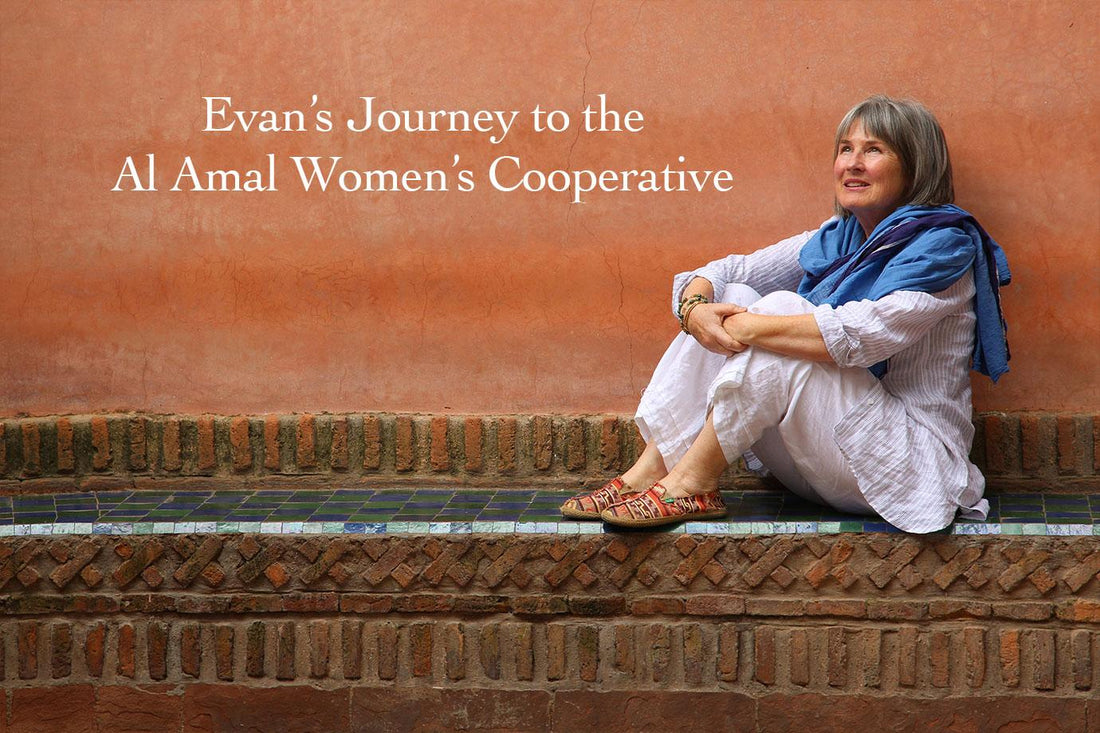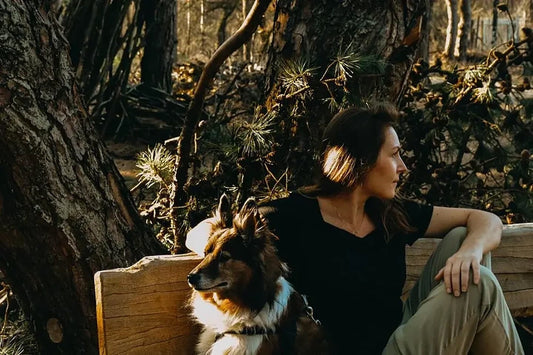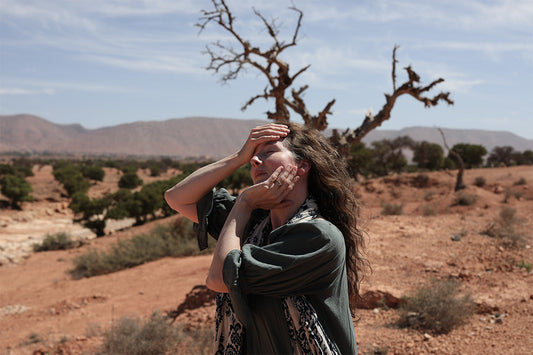
Argan. Praised golden oil of the Atlas mountains.
Traditional oil of the indigenous Berber (Amazigh) people. Created from the fruit pits of a twenty million year old species, its history of human use spans millennia.
Since we began working with argan oil, a handful of years ago, we have purchased exclusively from women’s co-operatives. We began by purchasing from a collective of twenty-two women’s co-operatives called the UCFA. Over time, we identified the argan oil from one specific co-operative within the UCFA as the most exquisite. That co-operative is Al Amal.
From that time forward, Al Amal has been the sole producer of our hand-pressed, certified organic argan oil we use in so many of our products. Similar to coffee, we sometimes like to think of it as single-origin argan.
This is the story of our journey to meet these incredible women for the first time, celebrate our relationship and that beautiful golden-thread that connects us, and begin the ceremonial planting of 400 argan trees.

Our journey begins in the fragrant and winding maze of the Old Medina in Marrakech. After flying through the night and much of the next day, we touched down in this mythic city, which became our gateway to the Anti-Atlas mountains and the realm of Argan.
Here, within the walls of the ancient imperial city, we spent a few days acclimating, observing, absorbing, and exploring.

In the Old Medina, the labyrinthine streets and narrow alleyways form a web filled with motorbikes, donkey carts, and so many people. Some trying to make their way through the ancient alleys, some trying to sell you things from their small shop stalls. Spices, shoes, rugs, soap, argan, metalwork, jewelry, leather. They’ll try on different languages until they find the one you seem to respond to.
In this part of town, there are no cars. They don’t fit.
This city is a beautiful clamor. A swirl of scent, sight and sound. An incomparable sensory feast of colors, textures, voices, and fragrance. Scents of spices wafting through the warm air. Of succulent tagine cooking all day. Of gasoline from the motorbikes, and of roses strewn throughout the cool riads.

Freshly dyed wool hangs from the rafters and shop owners cry out, “spices! spices!”, while men relax on the sidelines drinking Moroccan mint tea, any and every time of day.

Before dawn, the first call to prayer echoes from the minaret and stirs the world awake. It resounds through the city four more times before the day is through, and soon you grow to anticipate it with quiet excitement. A moment of stillness, of reverence, and a reminder to connect with something greater amongst the hustle and bustle of daily life. The haunting voice of the muezzin stays with me long after I’ve returned home.
In almost every shop, you will find glowing golden bottles of argan oil. I eye them curiously, but with suspicion. Amongst Moroccans, it’s common knowledge that most of the argan sold in the souks is adulterated and highly processed. Unless you’re buying it directly from the cooperatives, there’s really no way of verifying its purity.
In higher end shops, you can find the real deal, but even then it’s mostly roasted culinary argan oil. A delicacy still mostly under the radar in American kitchens, but very popular in Europe.
One thing is clear: Argan is a national treasure.





Morocco is a country of stark contrasts. The cities are dense, vivid, and pulsating with life.
The wilderness - vast, expansive, sprawling and open. Leaving Marrakech, we drove first through miles and miles of olive trees, and then broke out into the desert. The rolling hills, sometimes round and smooth, other times angular and geometric with beautiful and bold layers of strata in the rock. Soon, a sparse smattering of trees appear. Finally, argan trees.
If a plant can dominate a desert landscape, argan dominates the Anti-Atlas. In fact, on our drive, there is little else. The hills are dotted with the dark green ancient argan trees. They are shrub-like, scraggly, thorny and not very tall where trees are concerned. There is something almost prehistoric about them, which is understandable considering the fact that their species is 20 million years old. Like all desert plants, argan is drought resistant. Hardy and resilient, it seems this tree has a strong will. It refuses to be mono-cropped, and is incredibly difficult to grow outside of its native habitat. It is here, and only here, that it wants to be.
The indigenous people of this region of North Africa are the Amazigh, or as they’re more commonly known today, Berber. The name Berber was given to them by Greeks and Arabs, meaning ‘foreigners’ and is still used throughout Moroccan cities. These people self-identify as Amazigh (pronounced ah-mah-zeer), which means ‘Free People.’
Currently, Morocco has the highest population of Amazigh in all of North Africa.

For countless eons, Argan oil has been an integral part of Amazigh life. Most importantly, they have used it as their primary dietary fat, and to protect their skin from the blazing North African sun. Now, it is also their economic deliverer. In our modern era, Argan is the main source of income for many Amazigh families.
During the last century, Argan had a rocky few decades. With a growing population and a need for firewood, paired with excessive grazing from goats, the trees began to dwindle. After some time it became extremely evident just how big a problem this was and just how important argan is to the health of the Moroccan wilderness.
Luckily, timing aligned, and the rest of the world slowly became aware of argan’s outstanding attributes and soon cosmetic industry was abuzz with praise.

Now, the Argan “forest” of Morocco is a UNESCO protected biosphere. This means Argan trees can’t be cut without permission. It is widely acknowledged just how important a role argan plays in retaining the health of the soil, supporting the rhythmic life and fertility of the ecosystem and thus preventing desertification. Let alone how cherished argan oil is as an export.
The world’s demand for Argan is still high and there’s no sign of it slowing down. And why would there be? Argan is not an empty fad that will fade away in time. Argan is a timeless treasure, now cherished on a global level, and will always have a place in our lives.
Like many special plant allies that rise to a certain level of popularity (extra virgin olive oil & lavender essential oil, for example), Argan is now subject to adulteration and quality-diminishing mass production.
The highest quality is the oil produced from a recognized women’s co-operative. Harvested by hand, flesh of the fruit removed by hand, seed cracked by hand, oil pressed by hand. Certified Organic. This is the quality of oil created by the Al Amal Co-operative.
Before argan rose to fame in the western world, before it was mass produced, it was always hand-made by women. For their families, for their communities, for themselves.
There is a misconception that most of the argan coming from Morocco is created by women’s co-operatives. But according to the Belgian Development Agency, BEFAIR, less than 10% of the argan exported from Morocco is made by authentic women’s co-operatives.
Known as ‘ghost co-operatives’, these fake co-ops are controlled by local business people whose employees are paid far below fair labor rates. The Argan oil from these ‘ghost co-ops’ is likely produced from open, oxidized nuts, or nuts eaten, digested and excreted by goats. Often rancid, the oil would need to be deodorized to disguise the unpleasant smell.


For many people, argan oil is often associated with goats. Perhaps they’ve seen photos of goats adorning the branches of argan trees, or simply heard the story that goats climb the argan trees, eat the fruit, and then the seeds are collected from their droppings.
Some may find it romantic, others repulsive.
Whatever your feelings about it are, the reality is clear, simple, and undeniable: The oil produced from goat-excreted argan is greatly inferior.
Producers of argan oil who use goat-excreted argan nuts do so to cut corners, and remove a step of labor. When the nut passes through the goat's digestive tract, it absorbs the aroma of where it’s been. For it to be at all tolerable, it has to be deodorized and refined to eliminate the odor. Doing this removes much of the nutrients and thus much of the benefits. A common natural deodorization method utilized is steam-deodorization, which introduces extreme heat and water into the oil. This significantly reduces shelf life and seriously diminishes the integrity of the oil.

Traditionally hand-crafting argan oil is an incredibly labor-intensive process, but the difference in quality is worth every moment and every step it takes to create it.
When the argan fruit is fully ripe, it falls to the ground and is collected by hand. If picked directly from the tree, the oils in the kernel don’t have enough time to develop. The fallen fruit looks shriveled, but the kernels within are plump and juicy with oil.
A cart is filled with the hand-collected fruits and carted by donkey to the production area, where the real works begins. First, the flesh is removed and the nut is hand cracked with stone to reveal the small kernel within, similar to an almond or the soft kernel found inside the pit of a stone fruit. Then, the kernels are collected and placed into a stone mill and slowly ground to produce a slurry of ground argan. The slurry is then filtered to remove all sediment and fiber, and what remains is the clear and glowing golden oil, smelling sweet and nutty.
It takes one argan tree one year to produce one liter of argan oil.
The fruit is typically harvested between June and September. Instead of making one big batch for the year, Al Amal stores the dried fruit and makes the oil as needed throughout the year, ensuring optimal freshness.

We finally arrive into a stretch of wilderness a little outside of Tiznit. A desert valley speckled with argan trees, cradled amongst the small sloping peaks of the Anti-Atlas Mountains. We are just outside of the village where most of the women from Al Amal live.
As soon as we emerge from our vehicle, we hear their beautiful voices, rejoicing in song and carried over to us on the breeze. We make our way over to the tent they’ve erected especially for our celebration, keeping an eye out for scorpions. Before anything else, we’re swept into the celebration and enveloped in their circle of song. It’s the most beautiful greeting imaginable.
The leader of the co-op, Fatima, welcomes us and through layers of translation, we begin to share in our happiness of coming together. We talk about the circle of women here today, and extending beyond us, that argan unites. We talk about the power of women supporting women, and creating beauty in the world. Fatima says, Yes, We are from different places, cultures and climates but still connected, woven together with the golden thread of argan oil, with a shared desire to empower and uplift.

The women of the coop are heartfelt and warm, each with a sparkle in their eyes. I can’t help but notice their skin. It’s strikingly radiant - clear, luminous, plump. The product of genetics, lifestyle, stress-levels, and argan oil. And although these women may not possess monetary wealth, they are profoundly wealthy. These women are rich in love, in community, and connection and they radiate with something truly special.
Under the beautiful woven canopy the breeze lifts the fabric in a ripple, a pulse. The soft desert wind feels like a warm embrace.

Tea is served while we talk, and afterward, our group all agrees that this was the best tea of the entire trip. There’s something different about it, the taste of something wild and mysterious. Somehow capturing the whole sacred place in just a sip.
We share a meal of warm, herbed flat bread that we dip in roasted argan oil, local honey, local olive oil, and something called amlou, which is a blend of ground almonds, argan oil, and honey.





Now it is time to begin the ceremonial planting of our argan trees. We gather around the first hole and begin the ceremony. Two people carry and plant a sapling while the rest of the group sings blessing songs and cries out in ecstatic cheers. We do this one by one until everyone who wanted to plant a tree has.




Throughout much of the day, Fatima’s teenage son stays by our side. He speaks English and acts as a cultural translator for us, explaining nuances and details we might not otherwise be aware of. One of the songs sung during planting is in Arabic, blessing the sapling, another in Amazigh.

He tells us when the women of the co-operative work, they always sing. They want to bring joy into what they create.
I love knowing that not only is our argan oil created with love and intention, but with joyful song infusing each batch.
Once we have finished planting, there is more singing and dancing, and we finish our time with the women of Al Amal with a delicious meal, a heartwarming goodbye, some hugs, and a promise to return again.
To celebrate this trip, these women, this tree, and this land,
we have decided to share this pure, hand-pressed, traditional oil with our customers.
Pure, Authentic, Traditionally hand-crafted argan oil from the beautiful women of Al Amal Co-operative
Find Al Amal Co-operative Argan in the following products:
(click the images to find them in our store)
Blue Chamomile Day Moisturizer
Lavender Argan Light Moisturizer
Click below to watch our video of this incredible journey:









